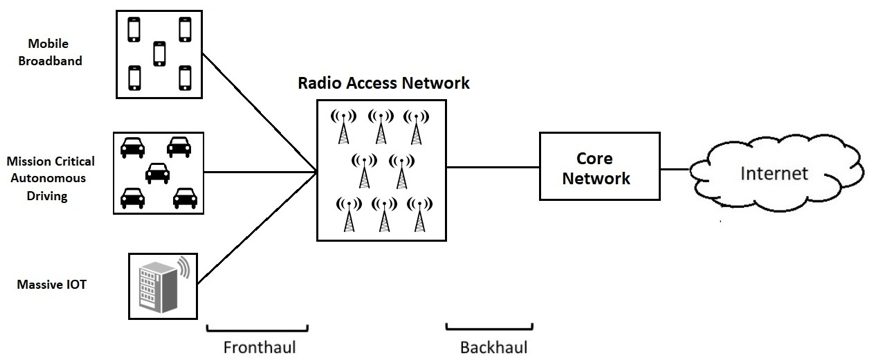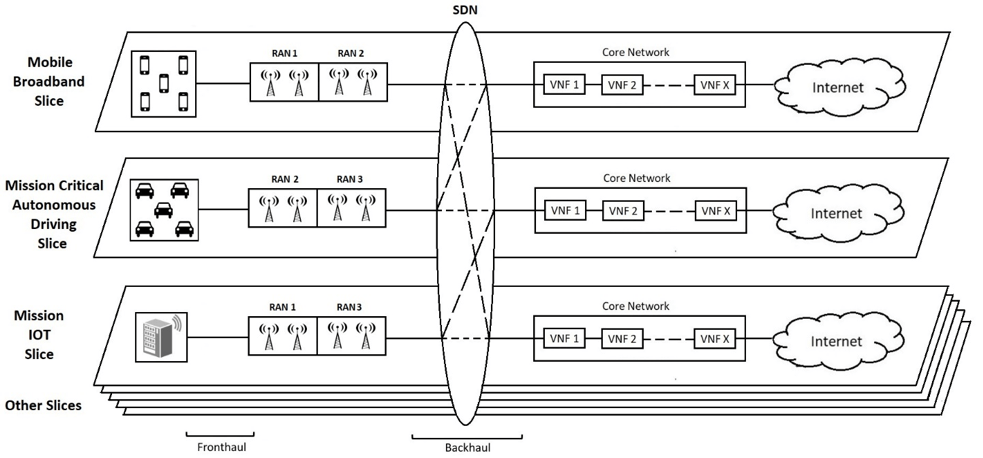Wireless
Network Slicing: Building Next-Generation Wireless Networks

Wireless communication growth has been on the rise, reaching newer industry segments such as the automotive and health industries. Each segment served by the wireless industry has different requirements, some needing ultra-high bandwidth while some requiring exceedingly low latency. With future wireless cellular Internet of Things (IoT) applications like 5G, Narrow-Band IoT (NB-IoT) and machine-to-machine (M2M) communications poised to offer diverse services with a mix of requirements, having dedicated networks that can perform dynamic resource utilization will be important.
Network slicing will play a pivotal role in addressing varied use cases by enabling dedicated virtualized network slices for each use case. This blog will emphasize how network slicing can help provide a cost-efficient way for Multiple System Operators (MSOs) to deliver differential services to the end user.
Why Should You Care About Network Slicing?
In the current one-size-fits-all approach implementation for wireless networks, most resources are underutilized and not optimized for high-bandwidth and low-latency scenarios. Fixed resource assignment for diverse applications with differential requirements may not be an efficient approach for using available network resources. Operators need a radical paradigm shift towards building smart dedicated networks that are ideal for providing differential set of services to the end user. However, building dedicated networks traditionally increases operators capital expenditures (CAPEX) and operational expenditures (OPEX). Network slicing will permit a more cost-effective implementation of dedicated networks.
Network slicing creates multiple dedicated virtual networks using a common physical infrastructure. Each virtual network slice is composed of independent logical network functions serving a specific use case. Each network slice can be optimized to provide the required resources and quality of service (QoS) with regards to latency, throughput, capacity, coverage and so on. Network slicing allows functional components to be shared among separate network slices while isolating each network slice, thereby avoiding interference. Thus, each network slice can be independently managed and orchestrated.
Network slicing is an efficient approach for simultaneously reducing OPEX and increasing revenue. Network slicing can act as a catalyst for adding flexibility, network scalability and efficient resource management. Network slicing will allow operators to analyze the OPEX and revenue generated on each slice independently.
Types of Network Slicing
Network slicing can be broadly classified into two types: vertical network slicing and horizontal network slicing.
Vertical network slicing allows resource sharing between different services and applications to enhance QoS. In vertical network slicing, each network node implements similar functions within a specific network slice. Vertical network slicing will segregate traffic on a per-application basis, providing users on-demand bandwidth. The end-to-end traffic with vertical network slicing usually transits between the core network and the end device.
Horizontal network slicing allows resource sharing among different network nodes to enhance the capabilities of less capable network nodes. Thus, horizontal network slicing needs over-the-air resource sharing across network nodes. In horizontal network slicing, new functions can be added for a network node when supporting a specific network slice. Horizontal network slicing segregates computing resources, providing capacity scaling, offloading and edge computing. The end-to-end traffic with horizontal network slicing usually transits locally between the access network and the end device.
The Role of NFV and SDN in Network Slicing
With fully commercialized 5G networks expected to be launched by 2020, Software-Defined Networking (SDN) and Network Functions Virtualization (NFV) will aid network slicing implementation. SDN and NFV will act as a basis for network slicing, allowing the efficient use of both physical and virtual resources.
SDN separates the control and user planes, providing a centralized architecture of the distributed network for efficient orchestration and automation. NFV decouples network functions from hardware elements to accelerate provisioning, optimize resource usage and increase operational efficiency.
SDN enables policy-based decisions to orchestrate the flow of traffic in a network. Thus, SDN benefits slicing by allowing dynamic configuration changes to subscriber policy for user, control and management planes. NFV ensures that the network’s capabilities align with the supporting virtualized environments. Thus, NFV benefits slicing by adding flexibility, allowing efficient scaling and allowing resource sharing across multiple network slices on a need basis. SDN enables the best path and moves more of the traffic processing on supported switches.
SDN and NFV commercial deployments are expected to grow, allowing network slicing to provide dynamic networks to meet the differential requirements of various applications and services. SDN and NFV will decrease CAPEX and OPEX, increase automation, reduce computational load and add dynamic scalability and flexibility. SDN and NFV are not dependent on each other, but there is synergy in combining the two.
Why Should MSOs Use Network Slicing?
Network slicing, although first applied to 5G networks, is now being applied to fixed network services such as fiber-to-the-home (FTTH). MSOs are currently offering quad-play services such as Internet, TV, home security and landline services. With the addition of cellular services to MSOs’ portfolios, network slicing could be an ideal solution. Each network slice can be optimized to provide the required resources and QoS to meet the diverse set of requirements for each service. Figures 1 and 2 show how the network slicing implementation would look when compared with the traditional network.

Figure 1: Traditional Network

Figure 2: Network Slicing Implementation
Vodafone and Huawei conducted a successful field trial of fixed-access network slicing by partitioning the physical FTTH network into multiple virtual network slices. Separate consumer and enterprise virtual network slices were created on a live FTTH network. The virtual network slices provide flexibility and full control to independently manage different customer bases using a single physical access network.
Network slicing will provide flexibility to optimize the operational processes on a per-service basis, allowing MSOs to independently manage the varied consumer base using a single physical access network. Network slicing will decrease OPEX by providing easy upgrades to virtualized software-defined solutions. Network slicing will provide scalability with horizontal slicing by using resources efficiently and will provide flexibility by vertically slicing the resources per application type. Network slicing will address varied throughput, latency, capacity and coverage requirements, with each slice tailored to meet needs on a per-service basis. Thus, network slicing will allow MSOs to independently manage the varied consumer base using a single physical access network.
Network Slicing Standardization
Network slicing standardization is in its early stages, with a focus on vertical slicing. Network slicing has been identified to play a pivotal role in 5G standardization. Currently, the wireless industry is focused on:
- Standardizing the implementation guidelines for network slicing
- Defining the ways and granularity of slicing
- Understanding the impacts of network slicing on the core networks, access networks and end devices.
Some of the working groups that are actively involved in the standardization efforts of network slicing include:
- Next Generation Mobile Networks (NGMN)
- 3rd Generation Partnership Project (3GPP)
- 5th Generation Infrastructure Public Private Partnership (5GPPP) Co-Funded framework
- Wireless World Research Forum (WWRF)
Fixed Access Network Sharing (FANS) architecture and equipment requirements have also been standardized by the Broadband Forum in Technical Report (TR-370).
How Can CableLabs Help?
CableLabs has done significant work addressing key technologies required for 5G around SDN and NFV. CableLabs has tried to explore:
- Cable access network virtualization
- Cable head-end low-latency edge computing
- Rapid prototyping using emerging SDN toolkits
- Developing a Virtual customer premises equipment (CPE) prototype
CableLabs is a leading contributor to the European Telecommunication Standards Institute NFV Industry Specification Group (ETSI NFV ISG). CableLabs SDN/NFV Application Development Platform and Stack (SNAPS) is part of Open Platform for NFV (OPNFV). CableLabs subsidiary Kyrio has built an NFV-SDN interoperability lab for vendors and operators to work together on their NFV and SDN solutions.
With the CableLabs TIP Community Lab, CableLabs is enabling deeper insights into the virtual RAN (vRAN) fronthaul interface. CableLabs has built a fully functional mobility lab with different types of Evolved Packet Core (EPC) architectures, including software-defined Cloud EPC and NFV-ready virtualized EPC (vEPC) solutions. The vEPC solutions have independent slices for management, control and user planes, providing utmost flexibility unlike physical node–based packet cores. CableLabs has also equipped the lab with virtualized solutions for IP Multimedia Subsystem (IMS) and Evolved Packet Data Gateway (ePDG) to provide end-to-end network virtualization.
Network slicing is a vital component for deploying future networks
MSOs should look at implementing network slicing in their networks to add flexibility, scalability and resource usage optimization. Network slicing will allow MSOs to independently manage and orchestrate each network slice, tailored to serve specific use cases. Thus, network slicing will allow operators to provide differential services to the end user in a cost-effective manner.
MSOs can learn more about network slicing by actively participating in various standards groups. Alternatively, MSOs can reach out to CableLabs/Kyrio to test network slicing implementation to evaluate benefits and drawbacks. MSOs can leverage the existing virtualized and cloud-based infrastructures within CableLabs to enhance MSOs’ cellular offerings and build a 5G-ready network. MSOs can also use the infrastructure within CableLabs to test their own virtualized solutions. CableLabs is currently evaluating the functionality of virtualized solutions and in the near future plans to test the performance with respect to network slicing.




